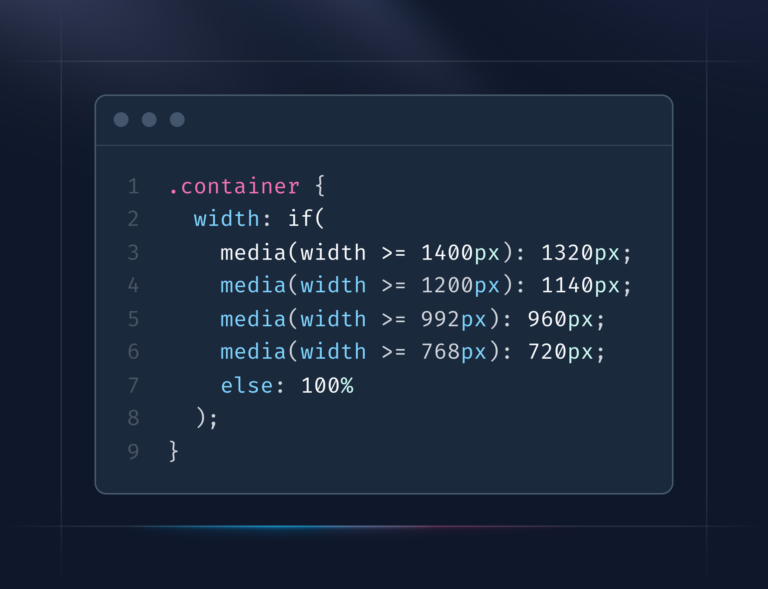Introduction
For years, front-end developers have relied on JavaScript or CSS preprocessors to apply conditional logic in stylesheets. From toggling classes to writing endless media queries, there was never a native way to say “if this, then that” directly in CSS, until now. The new CSS if() function officially launched in Chrome 137 (September 2025), and it’s a total game changer. This new feature lets developers write conditional logic directly inside CSS, no JavaScript, no Sass, no workarounds.
Let’s break down how it works, where you can use it, and what it means for the future of styling.
What Is the CSS if() Function?
The CSS if() function introduces conditional logic that allows you to set a property’s value depending on specific conditions, similar to traditional programming languages.
The syntax looks like this:
property: if(
condition-1: value-1;
condition-2: value-2;
else: default-value
);The browser checks each condition in order, when one matches, that value is applied. If none match, the else value is used. It’s declarative, elegant, and fast.
This small but powerful addition means you can now handle dynamic styling without JavaScript or class toggling, keeping your CSS cleaner and more maintainable.
3 Key Ways to Use the if() Function
1. Style Queries: React to CSS Variables
You can now respond to custom properties dynamically using the style() condition.
.card {
--status: attr(data-status type(<custom-ident>));
border-color: if(
style(--status: pending): royalblue;
style(--status: complete): seagreen;
style(--status: error): crimson;
else: gray
);
}With this, a single data-status attribute can control your entire card’s color scheme, no extra classes or JavaScript required.
2. Media Queries: Responsive Design Made Simpler
Instead of writing multiple @media blocks, you can now define responsive values inline:
h1 {
font-size: if(
media(width >= 1200px): 3rem;
media(width >= 768px): 2.5rem;
media(width >= 480px): 2rem;
else: 1.75rem
);
}This makes your CSS more compact, readable, and easier to maintain, perfect for design systems and modern component libraries.
3. Feature Detection: Smarter Fallbacks
With supports(), you can safely use modern CSS features and define fallbacks if the browser doesn’t support them:
.element {
border-color: if(
supports(color: lch(0 0 0)): lch(50% 100 150);
supports(color: lab(0 0 0)): lab(50 100 -50);
else: rgb(200, 100, 50)
);
}No more random fallback strategies or polyfills, the browser automatically applies what it supports.
Real-World Examples
Dark Mode in Just a Few Lines
body {
--theme: "dark";
background: if(
style(--theme: "dark"): #1a1a1a;
else: white
);
color: if(
style(--theme: "dark"): #e4e4e4;
else: #333
);
}Switch themes instantly, no scripts, no flicker.
Responsive Containers Without Media Query Chaos
.container {
width: if(
media(width >= 1400px): 1320px;
media(width >= 1200px): 1140px;
media(width >= 992px): 960px;
media(width >= 768px): 720px;
else: 100%
);
}Say goodbye to cluttered media query blocks. Your CSS becomes more fluid and component-driven.
Browser Support (as of October 2025)
| Browser | Support |
|---|---|
| ✅ Chrome / Edge | Version 137+ |
| ✅ Chrome Android | Version 139+ |
| ❌ Firefox | In development |
| ❌ Safari | On the roadmap |
| ❌ Opera | Coming soon |
💡 Tip:
You can use fallback values for older browsers. For example:
.button {
padding: 1rem 2rem; /* fallback */
padding: if(
style(--size: small): 0.5rem 1rem;
style(--size: large): 1.5rem 3rem;
else: 1rem 2rem
);
}The Future of Conditional CSS
The CSS Working Group is already exploring next-level features for the if() function, including:
- Range queries:
if(style(--value > 100): ...) - Logical operators:
if(style(--a: true) and style(--b: false): ...) - Container query integration: Bringing deeper contextual awareness to components.
This means CSS is evolving into a logic-capable language, capable of handling state, layout, and design adaptation, all declaratively.
Internal Link (for Codeblib)
- Next.js 16 Performance Checklist: 10 Must-Do Optimizations for Faster Builds and Runtime
- How to Set Up Serverless Functions in Next.js on Vercel
- Next.js 16 Parallel Routes Breaking Change: The default.js Fix Explained
- Mastering Next.js 16 Build Adapters API: The Key to True Self-Hosting and Custom Deployment
Final Thoughts
The CSS if() function isn’t just a new syntax, it’s a paradigm shift in how we write styles.
By embedding logic directly into CSS, developers can reduce JavaScript dependency, simplify responsive design, and build more scalable design systems.
While browser support is still expanding, the if() function marks the start of a new era in CSS, one that’s smarter, faster, and far more intuitive.
